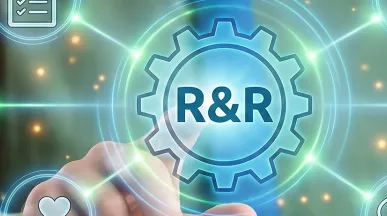Rewards and Recognition Programs Improve Business Performance

By Craig Sukenic
Ignoring employee engagement can be costly. Strong employee engagement is an indicator of employee satisfaction, a healthy organizational culture, and a sustainable business. Let’s dive deeper into the relationship between employee engagement and better business outcomes, and explore how employee recognition can help boost both.
Historically, high employee engagement is linked with improved employee retention, increased revenue, lower operational costs, and higher productivity. Unfortunately, as Gallup reports, employee engagement began lagging at the end of 2021 and the slump continues — the percentage of engaged employees is dropping while the number of workers who are “actively disengaged” is on the rise. This trend suggests that employers need to work even harder (or rather, smarter) to put employee engagement strategies into action if they want to reap the benefits.
Ignoring employee engagement can be costly. Strong employee engagement is an indicator of employee satisfaction, a healthy organizational culture, and a sustainable business. Let’s dive deeper into the relationship between employee engagement and better business outcomes, and explore how employee recognition can help boost both.
The high cost of disengagement
If employees are disengaged — or even not engaged enough — business can suffer. Gallup found that ignoring engagement costs the global economy 8.1 trillion dollars each year. By working to improve employee engagement and job satisfaction, business leaders can boost profitability, improve customer satisfaction, and even encourage a safer workplace and more inclusive work culture.
Here are a few performance outcomes linked to employee engagement:
- Higher retention. A Gallup survey found that organizations that make employee recognition a priority have workers who are 56% less likely to be looking for a new job.
- Increased productivity and profitability. Gallup reports that organizations with the highest levels of employee engagement are 17% more productive and 21% more profitable than those with a disengaged workforce.
- Improved workplace safety. Organizations with the highest employee engagement report 70% fewer employee safety incidents than those with the lowest engagement.
Ignoring or underestimating the importance of employee engagement could mean your organization misses out on these gains. This will make it more difficult to compete in your industry, both in terms of talent acquisition and business sales.
How employee recognition impacts the bottom line
Making employee recognition part of your organizational culture can curb expenses, big time. Gallup also calculated that an organization with 10,000 employees can save $16.1 million in turnover costs annually when they make recognition and emotional connection part of the culture. For many organizations, that’s the difference between barely staying afloat and being a fierce competitor in your industry.
We also know that having great employee recognition practices and tools can make employees feel valued, and support higher levels of employee engagement. In fact, Deloitte research shows that employee productivity, performance, and engagement are 14% higher in organizations with formal recognition programs, compared with those without them.
Additionally, effective recognition programs are linked with lower voluntary turnover (by as much as 31% according to Bersin and Associates). Investing in rewards and recognition is less costly than hiring to backfill vacant positions and frees up staff to concentrate on building your organizational culture. Our infographic illustrates how an organization with 10,000 employees could face $5.5 million or more in turnover costs each year or can opt to spend $250,000 on a rewards and recognition program that boosts engagement.
This relationship illustrates how investing in better employee recognition can, in turn, have a positive impact on your business's bottom line by helping you invest in the employees you have and saving millions in turnover costs.
How can recognizing and rewarding employees boost engagement, exactly? Social Recognition, which can be manager-to-direct-report or peer-to-peer, is one way to build trust and foster relationships within your organization, a necessary foundation for high engagement. Employee rewards and recognition can also help reduce or avoid burnout, another surefire way to protect against disengagement and the resulting employee turnover.
Using real data to drive decisions
One of the keys to putting these findings to work for your organization is having a reliable, accurate way to measure employee engagement. This documentation will enable human resources to collect and use real data to inform your decision-making around employee rewards and recognition and assess ROI. HubSpot outlines how HR leaders can measure engagement in both quantitative and qualitative ways. This will provide the best possible mix of data on which to base your important strategies around the employee experience, productivity, and organizational health.
Typically, HR is closest to the concept of employee engagement, with individual business units generally feeling the initial impacts (positive and negative). This means it is crucial for finance leaders and the C-suite to prioritize employee engagement as part of the organization’s broader strategies around business health, sustainability, and competitive advantage. As the research illustrates, businesses perform better when employee rewards and recognition are an integral part of organizational culture — and that’s only possible with support from executive leadership.
Implementing an action plan, along with technology designed to support and facilitate employee rewards and recognition programs, helps influence a more positive and inclusive work culture and boosts employee engagement. Tools like Connects can act as a foundation to achieve higher levels of engagement so you can boost engagement, productivity, and profitability while controlling turnover and other high costs of a disengaged workforce.





